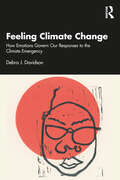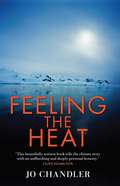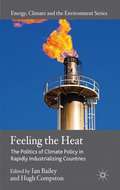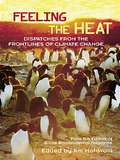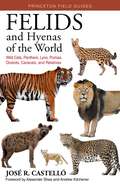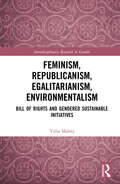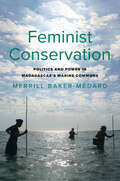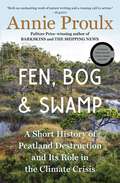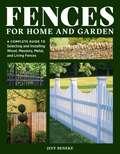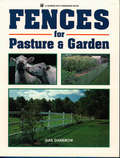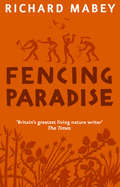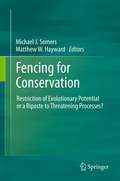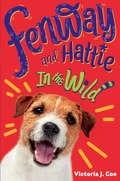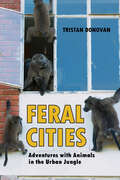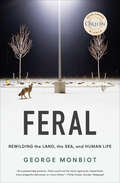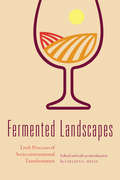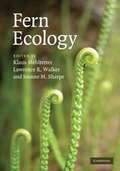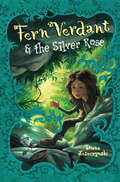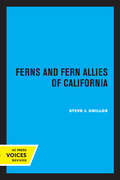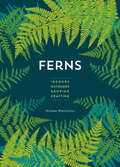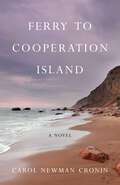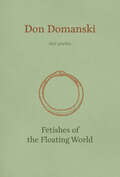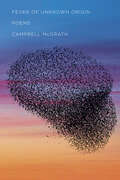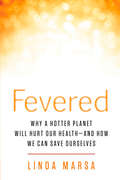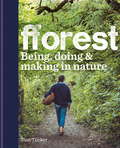- Table View
- List View
Feeling Climate Change: How Emotions Govern Our Responses to the Climate Emergency
by Debra J. DavidsonExamining the social response to the mounting impacts of climate change, Feeling Climate Change illuminates what the pathways from emotions to social change look like—and how they work—so we can recognize and inform our collective attempts to avert further climate catastrophe.Debra J. Davidson engages with how our actions are governed by a complex of rules, norms, and predispositions, central among which operates our emotionality, to assess individual and collective responses to the climate crisis, applying a critical and constructive analysis of human social prospects for confronting the climate emergency in manners that minimize the damage and perhaps even enhance the prospects for meaningful collective living.Providing a crucial understanding of our emotionality and its role in individual behaviour, collective action, and ultimately in social change, this book offers researchers, policymakers, and citizens essential insights into our personal and collective responses to the climate emergency.
Feeling The Heat
by Jo ChandlerIn Feeling the Heat, journalist Jo Chandler sets out on a quest that takes her across the Antarctic ice, under the seas and through the tropical rainforests of far north Queensland. Her mission is to explore one of the defining mysteries of our age-climate change. The story Chandler tells is an epic adventure complete with heroes and villains. It's a love story for those with an affection for nature. A reality show like no other. It's also a story of science in its most glorious, pure form. Chandler takes us into wild landscapes in the company of scientists trying to decode climate information that will be critical to the decisions we make for the future of the planet. Written in the vein of Susan Orlean's The Orchid Thief, and by turn lyrical, funny, and achingly sad, Feeling the Heat reveals startling truths about that delicate, confounding organism we call Earth. Winner: 2012 Bragg UNSW Press Prize for Science Writing Shortlisted: 2011 Queensland Premier's Literary Awards Science Writer Award Longlisted: 2012 John Button Prize
Feeling the Heat
by Ian Bailey Hugh CompstonTo avoid uncontrolled climate change, greenhouse gas emissions will have to be brought under control by major emitters outside the affluent West. The authors investigate the political obstacles in BRIC countries and what their governments could do to strengthen climate policies without incurring serious political damage.
Feeling the Heat: Dispatches from the Front Lines of Climate Change
by From the Editors of E/The Environmental MagazineFor an increasing number of people, global warming is not an academic and scientific debate, but a matter of survival. As the planet warms at a rate of four degrees Fahrenheit per century, violent storms are increasing in frequency, icebergs are melting, sea level is rising, species are losing their habitats, and temperature records are being broken. Feeling the Heat consists of chapter-length visits by well-known authors to actual world "hot" spots, where people are already coping day-to-day with the consequences of climactic disruption. The locations for the book were strategically chosen because each represents a separate and important global warming impact, such as rising tides, melting glaciers, evolving ecosystems and air pollution. Feeling the Heat takes global warming out of the realm of armchair speculation and arcane scientific debate, revealing the process of climate change to be ongoing, serious and immediate.
Felids and Hyenas of the World: Wildcats, Panthers, Lynx, Pumas, Ocelots, Caracals, and Relatives
by Dr. José R. CastellóThe most comprehensive and user-friendly photographic field guide to the world’s wildcats and hyenasFrom the Leopard Cat of Asia, the Black-footed Cat of Africa, and the Amur Tiger of Siberia to South America’s Ocelots and North America’s Bobcats, the wildcats known as felids are among the most fascinating and spectacular of all animals. This stunningly illustrated book is the most comprehensive and user-friendly guide to the world’s felids and their often misunderstood relative, the hyenas. Covering and illustrating every species and subspecies, the guide features more than 150 superb full-color plates that incorporate more than 600 photographs and show species in similar poses for quick and easy comparison. Drawing on the latest taxonomy and research, the facing-page species accounts provide distribution maps, common and scientific names, and detailed information on key identification features, distribution, behavior, reproduction, similar species, habitat, conservation status, and where to observe each species. An ideal field companion for use anywhere in the world, the book will appeal to both casual nature enthusiasts and seasoned professionals.Covers 41 felids and 4 hyenas—every species and subspecies in the worldFeatures more than 150 color plates incorporating more than 600 photosDepicts species in similar poses for quick and easy comparisonsProvides key identification information in detailed, facing-page species accountsUses the latest taxonomyIncludes easy-to-read distribution maps and tips on where to observe each species
Feminism, Republicanism, Egalitarianism, Environmentalism: Bill of Rights and Gendered Sustainable Initiatives (Interdisciplinary Research in Gender)
by Yulia MaletaThis book addresses hegemonic ruling class masculinity and emphasized femininity within renewables organisational governance, and critiques Anglo-Celtic male privilege, as a barrier to women’s leadership participation. Primarily using the Australian socio-political context, the author considers the patriarchal control of organisations and renewables governance, and argues that women-led emphasized femininity-resistance strategies can challenge the hegemonic status of ruling elites to create a leadership that is less power oriented, more collaborative and open to change. Utilising detailed interviews with Australian women environmentalists, together with feminist, sociological and social movement theory, whilst considering the historic context of Red Vienna and contemporary political challenges (Brexit, Monarchism etc.), it puts forward an innovative policy framework for an Australian Bill of Rights Act and republican constitutional change. Written for academics, activists and policymakers alike, this book offers a unique insight into women’s inequity within patriarchal institutionalist governance. It will be engaging and inspiring reading for feminist and environmentalist activists and practitioners, in addition to professional associations focussing on gender, justice and environmental change. Academics and postgraduates in Gender Studies, Ecofeminism, Sociology and Organisational Studies will also find the book of key interest in its interdisciplinary discussions of Sustainable Scientific-Technological Development Initiatives (SSTDI) and feminism in an Australian political context.
Feminist Conservation: Politics and Power in Madagascar's Marine Commons (Yale Agrarian Studies Series)
by Merrill Baker-MedardHow access to and control over marine resources in Madagascar are negotiated, and the inextricable link between equity and sustainability As marine conservation becomes an increasingly urgent issue around the world, there is an equally critical need to understand the ways different conservation interventions attend to or exacerbate social inequality. This book explores the origins of a conservation agenda in Madagascar and the consequences of its neglect of gender. Drawing on interviews, ecological and social surveys, archival research, and several years of living with fishers in Madagascar, Merrill Baker-Médard examines how access to and control over marine resources are negotiated from fishing villages to the conference rooms of international meetings. Her intersectional approach bridges conservation science, gender studies, and human geography to advance the idea that equity and sustainability are inextricably linked and that practices of reciprocity, accountability, and care are foundational to their achievement.
Fen, Bog and Swamp: A Short History of Peatland Destruction and Its Role in the Climate Crisis
by Annie Proulx*Named a Best Book of the Year by The New Yorker and Literary Hub!* A Finalist for the 2022 NBCC Awards in Nonfiction, the 2023 Phillip D. Reed Environmental Writing Award, and the NEIBA 2023 New England Book Award* From Pulitzer Prize winner Annie Proulx, this riveting deep dive into the history of our wetlands and what their systematic destruction means for the planet &“is both an enchanting work of nature writing and a rousing call to action&” (Esquire). &“I learned something new—and found something amazing—on every page.&” —Anthony Doerr, author of All the Light We Cannot See and Cloud Cuckoo LandA lifelong acolyte of the natural world, Annie Proulx brings her witness and research to the subject of wetlands and the vitally important role they play in preserving the environment—by storing the carbon emissions that accelerate climate change. Fens, bogs, swamps, and marine estuaries are crucial to the earth&’s survival, and in four illuminating parts, Proulx documents their systemic destruction in pursuit of profit. In a vivid and revelatory journey through history, Proulx describes the fens of 16th-century England, Canada&’s Hudson Bay lowlands, Russia&’s Great Vasyugan Mire, and America&’s Okeefenokee National Wildlife Refuge. She introduces the early explorers who launched the destruction of the Amazon rainforest, and writes of the diseases spawned in the wetlands—the Ague, malaria, Marsh Fever. A sobering look at the degradation of wetlands over centuries and the serious ecological consequences, this is &“an unforgettable and unflinching tour of past and present, fixed on a subject that could not be more important&” (Bill McKibben). &“A stark but beautifully written Silent Spring–style warning from one of our greatest novelists.&” —The Christian Science Monitor
Fences for Home and Garden: A Complete Guide to Selecting and Installing Wood, Masonry, Metal, and Living Fences
by Jeff BenekeFrom a home-improvement expert, a guide to building just the right fence to serve your individualized needs. This complete guide shows homeowners how to: *build fences that provide privacy and security *mark boundaries *hide unpleasant views *keep animals in or out *beautify a yard *provide protection from the elements. Author Jeff Beneke guides readers through the building process with illustrated step-by-step instructions. Also included is information on how to repair fences and gates that have been damaged over time.
Fences for Pasture & Garden
by Gail DamerowWhether you’re trying to protect your garden from wildlife predators or want to keep your livestock from wandering too far, effective fencing can bring welcome peace of mind. Covering the pros and cons of a variety of fencing types, Gail Damerow shows you how to build a fence that works for your needs. With clearly illustrated instructions for building wire fences, rail fences, electric fences, woven fences, and more, you’ll soon be creating effective enclosures that are guaranteed to save you time, money, and worry.
Fencing Paradise: The Uses and Abuses of Plants
by Richard MabeyIn this remarkable journal of visits to Eden, Mabey transports his reader from Cornwall to the Mediterranean to the Tropics, from Old World to New, from present to personal memory, to new perspectives on our collective artistic and emotional past. Sensuous and evocative, exquisitely written, his new book challenges the reader to look differently at the world, and our place in the landscape. At the same time, Mabey is controversial in his views about what we mean by buzz words like 'renewable', or 'sustainable', and he is highly provocative in his final response to the Eden Project itself.
Fencing for Conservation
by Michael J. Somers Matthew HaywardThe conflict between increasing human population and biodiversity conservation is one of the IUCN's key threatening processes. Conservation planning has received a great deal of coverage and research as a way of conserving biodiversity yet, while theoretically successful, it has never been tested. Simple lines on maps to illustrate conservation areas are unlikely to be successful in the light of human encroachment. It may be that some form of overt display is necessary to ensure the protection of reserves. This may be signage, presence of guards/rangers or physical fencing structures. The need for some form of barrier goes beyond restricting human access. The megafauna of Africa pose a genuine threat to human survival. In southern Africa, fences keep animals in and protect the abutting human population. Elsewhere, fencing is not considered important or viable. Where poverty is rife, it won't take much to tip the balance from beneficial conservation areas to troublesome repositories of crop-raiders, diseases and killers. Conversely, in New Zealand fences are used to keep animals out. Introduced species have decimated New Zealand's endemic birds, reptiles and invertebrates, and several sites have been entirely encapsulated in mouse-proof fencing to ensure their protection. Australia faces the same problems as New Zealand, however surrounds its national parks with cattle fences. Foxes and cats are free to enter and leave at will, resulting in rapid recolonisation following poisoning campaigns. How long will these poison campaigns work before tolerance, aversion or resistance evolves in the introduced predator populations?
Fenway and Hattie in the Wild (Fenway and Hattie #4)
by Victoria J. CoeIn the fourth book in the adorable middle-grade series, Fenway gets a taste of the wild when he goes on a back-to-school camping trip with Hattie. When Hattie starts using a word Fenway hasn't heard in a long, long time - "skool" - some other things change as well. Hattie's bushy ponytail disappears, clothes that smell like no one ever wore them get tossed around her room, and she smells nervous much more than usual. Then the family fills the Food Box with yummy hot dogs and loads it in the car. Fenway is thrilled that he gets to go along where ever they are going, and is even more excited when they arrive in the wilderness with tons of new scents to investigate, dogs and humans to meet, and lots of meat cooking over fires. Hattie seems excited about it all, too, and happy her friend Angel also came, but when more families arrive with lots of new kids, she smells nervous again. Especially when one certain kid that all the others seem to follow everywhere starts bossing everyone around. Fenway can sympathize, because a tiny dog is doing the same thing to all the other dogs. Fitting in can be a tough business, but luckily both Fenway and Hattie come around to realizing that being true to themselves is much more important.
Feral Cities: Adventures with Animals in the Urban Jungle
by Tristan DonovanWe tend to think of cities as a realm apart, somehow separate from nature, but nothing could be further from the truth. In Feral Cities, Tristan Donovan digsbelow the urban gloss to uncover the wild creatures that we share our streets and homes with, and profiles the brave and fascinating people who try to manage them. Along the way readers will meet the wall-eating snails that are invading Miami, the boars that roam Berlin, and the monkey gangs of Cape Town. From feral chickens and carpet-roaming bugs to coyotes hanging out in sandwich shops and birds crashing into skyscrapers, Feral Cities takes readers on a journey through streets and neighborhoods that are far more alive than we often realize, shows how animals are adjusting to urban living, and asks what messages the wildlife in our metropolises have for us.
Feral: Rewilding the Land, the Sea, and Human Life
by George MonbiotAn optimistic approach to environmentalism that focuses on the wonders of rewilding, not just the terrifying consequences of climate change. To be an environmentalist early in the twenty-first century is always to be defending science and acknowledging the hurdles we face in our efforts to protect wild places and fight climate change. But let&’s be honest: hedging has never inspired anyone. So what if we stopped hedging? What if we grounded our efforts to solve environmental problems in hope instead, and let nature make our case for us? That&’s what George Monbiot does in Feral, a lyrical, unabashedly romantic vision of how, by inviting nature back into our lives, we can simultaneously cure our &“ecological boredom&” and begin repairing centuries of environmental damage. Monbiot takes readers on an enchanting journey around the world to explore ecosystems that have been &“rewilded&”: freed from human intervention and allowed—in some cases for the first time in millennia—to resume their natural ecological processes. We share his awe as he kayaks among dolphins and seabirds off the coast of Wales and wanders the forests of Eastern Europe, where lynx and wolf packs are reclaiming their ancient hunting grounds. Through his eyes, we see environmental success—and begin to envision a future world where humans and nature are no longer in conflict, but are part of a single, healing world.
Fermented Landscapes: Lively Processes of Socio-environmental Transformation
by Colleen C. MylesFermented Landscapes applies the concept of fermentation as a mechanism through which to understand and analyze processes of landscape change. This comprehensive conceptualization of &“fermented landscapes&” examines the excitement, unrest, and agitation evident across shifting physical-environmental and sociocultural landscapes as related to the production, distribution, and consumption of fermented products. This collection includes a variety of perspectives on wine, beer, and cider geographies, as well as the geography of other fermented products, considering the use of &“local&” materials in craft beverages as a function of neolocalism and sustainability and the nonhuman elements of fermentation. Investigating the environmental, economic, and sociocultural implications of fermentation in expected and unexpected places and ways allows for a complex study of rural-urban exchanges or metabolisms over time and space—an increasingly relevant endeavor in socially and environmentally challenged contexts, global and local.
Fern Ecology
by Klaus Mehltreter Lawrence R. Walker Joanne M. SharpeFerns are an integral part of the world's flora, appreciated for their beauty as ornamentals, problematic as invaders and endangered by human interference. They often dominate forest understories but also colonize open areas, invade waterways and survive in nutrient-poor wastelands and eroded pastures. Presented here is the first comprehensive summary of fern ecology, with worldwide examples from Siberia to the islands of Hawaii. Topics include a brief history of the ecological study of ferns, a global survey of fern biogeography, fern population dynamics, the role of ferns in ecosystem nutrient cycles, their adaptations to xeric environments and future directions in fern ecology. Fully illustrated concepts and processes provide a framework for future research and utilization of ferns for graduate students and professionals in ecology, conservation and land management.
Fern Verdant & the Silver Rose
by Diana LeszczynskiFERN WISHES SHE had normal parents and a normal name. Instead, she has eccentric botanist parents who named herFern,after her father’s favorite plant. Lily, Fern’s mother, assures her one day she’ll understand their love of plants, but Fern can’t believe it. She hates plants and could do with less of them in her life. Then Lily disappears suddenly while attending to a mysterious and rare Silver Rose. Fern and her dad are heartbroken, but have no idea what could have happened, until one day, Fern learns she has a one-of-a-kind talent: she can communicate with plants, and so could her mother! Using her newfound skill, she learns that her mother is in terrible danger, and she is the only one who can save her. With a little help from her friends, the plants . . .
Ferns and Fern Allies of California (California Natural History Guides #16)
by Steve J. GrillosThis title is part of UC Press's Voices Revived program, which commemorates University of California Press’s mission to seek out and cultivate the brightest minds and give them voice, reach, and impact. Drawing on a backlist dating to 1893, Voices Revived makes high-quality, peer-reviewed scholarship accessible once again using print-on-demand technology. This title was originally published in 1966.
Ferns: Indoors - Outdoors - Growing - Crafting
by Mobee WeinsteinA concise, creative, practical guide to growing these amazing plants, drawn from the award-winning volume The Complete Book of Ferns.A more concise version of The Complete Book of Ferns, focused on practical use for gardeners, Ferns offers botanical information, indoor and outdoor growing and care information, details on propagation, display ideas, and even craft projects. With numerous color photos, it will help you add a new dimension to your home or backyard garden reflecting the beauty and wide variety of this hardy plant that dates back to before the time of the dinosaurs.Acclaim for The Complete Book of FernsWinner of an American Horticultural Society Book Award“A lovely and multifaceted exploration . . . as useful as it is educational.” —Publishers Weekly
Ferry to Cooperation Island: A Novel
by Carol Newman CroninLoner James Malloy is a ferry captain—or used to be, until he was unceremoniously fired and replaced by a girl named Courtney Farris. Now, instead of piloting Brenton Island&’s daily lifeline to the glitzy docks of Newport, Rhode Island, James spends his days beached, bitter, and bored. When he discovers a private golf course staked out across wilderness sacred to his dying best friend, a Narragansett Indian, James is determined to stop such &“improvements.&” But despite Brenton&’s nickname as &“Cooperation Island,&” he&’s used to working solo. To keep rocky bluffs, historic trees, and ocean shoreline open to all, he&’ll have to learn to cooperate with other islanders—including Captain Courtney, who might just morph from irritant to irresistible once James learns a secret that&’s been kept from him for years. This salt-sprayed fourth novel by 2004 Olympic Sailor Carol Newman Cronin celebrates wilderness and water, open space and open-mindedness, and the redemptive power of neighborly cooperation.
Fetishes of the Floating World
by Don DomanskiGovernor General's Award–winning poet Don Domanski's posthumous last collection once again melds perception-expanding environmental poetry and metaphysics into a seamless, moving lyric whole. Fetishes of the Floating World continues Don's lifelong exploration of mystical ecology. It is an invitation to experience the sacred dimensions of what-is and to become more intimate with the strangeness that haunts our lively, changeable world. Here is a spirituality that doesn't turn its back on the material and immerses us in earthly being. The sustained apprehension of deep time underlies every moment of this work; every moment is held up against that more-than-human span and is relinquished to it. Domanski's full-bodied, incantatory language will penetrate your very marrow, calling you out of yourself to testify to the world's "inclement graces." "Domanski’s poems are intimate, but intimate on a grand scale. As far as I am concerned, there is no better poet writing in English."–Mark Strand on All Our Wonder Unavenged
Fever of Unknown Origin: Poems
by Campbell McGrathA collection of profound and piercing poems from a finalist for the Pulitzer Prize about navigating the modern world in search of beauty that will endureFever of Unknown Origin opens at a remote crossroads, where the speaker considers the intersection of history, beauty, and destruction: &“the past / is paper / and the present, a match . . .&” What follows is an urgent tour of landscapes—environmental, political, and personal—that reframes our perception of modern America and leads the reader into &“An empire of rags and photons&” where we must look to the past to clarify our futures.With sublime wit and a Whitmanian eye, McGrath delivers a stunning collection of warnings, love letters, and praise songs for all that manages to weather the perennial pressures of time: frog ponds, stadium rubble, and the endless cycle of seasons, which usher us deeper into an era we cannot yet know.
Fevered: Why a Hotter Planet Will Hurt Our Health -- and how we can save ourselves
by Linda MarsaBeyond images of emaciated polar bears and drought-cracked lakes, there remains a major part of climate change's impact that the media has neglected: how our health will suffer from higher temperatures and extreme weather. From spiraling rates of asthma and allergies and spikes in heatstroke-related deaths to swarms of invasive insects carrying diseases like dengue or West Nile and increases in heart and lung disease and cancer, the effect of rising temperatures on human health will be far-reaching, and is more imminent than we think.In Fevered, award-winning journalist Linda Marsa blends compelling narrative with cutting-edge science to explore the changes in Earth's increasingly fragile support system and provide a blueprint—a "medical Manhattan Project"—detailing what we need to do to protect ourselves from this imminent medical meltdown. In the tradition of Rachel Carson's Silent Spring, Marsa sounds the alarm on a subject that has largely been ignored by governments and policy makers, and persuasively argues why preparedness for the health effects of climate change is the most critical issue affecting our survival in the coming century.
Fforest: Being, Doing & Making in Nature
by Sian TuckerCalming to the soul and good for us all, spending time outdoors offers us precious breathing space away from the stresses and strains of modern life. This inspirational guide celebrates the life enhancing effect of nature and encourages you to try the pursuits that would have been second nature to previous generations - from walking in the dark with only the light of the moon and stars to guide you, to wild swimming, forest bathing and sleeping under canvas. It will inspire you to re-discover the joy of sky and clouds, night and tides, stars and silence. <P><P>Photography by Finn Beales
